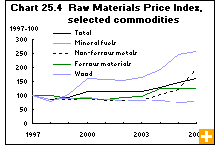Common menu bar links
Heavy Metals
Archived Content
Information identified as archived is provided for reference, research or recordkeeping purposes. It is not subject to the Government of Canada Web Standards and has not been altered or updated since it was archived. Please contact us to request a format other than those available.
While prices rise for many reasons, a major force behind inflation is the rising cost of the materials that go into the products we buy—the raw materials and industrial products manufacturers use to make their own products. In recent years, metals prices have pushed up commodity prices.
Manufacturers of metal products start production by buying unprocessed ferrous or non-ferrous metals that are mined or extracted from the ground. The Raw Materials Price Index (RMPI), which tracks prices paid by manufacturers for key raw materials such as metals, shows that the cost of metals has gone through the roof since 2001.
In 2006, while prices for unprocessed ferrous metal—in other words, iron ore—have risen 39 % since 1997 (the current base year of the RMPI), the most dramatic price growth has been in the non-ferrous metals category (96%). Canada’s uranium miners—many of which are found in Saskatchewan—have seen prices of radioactive concentrates nearly quadruple. Prices for copper, nickel and zinc concentrates have also risen sharply: copper theft from residential homes has become a strange but growing trend. Precious metals such as gold and palladium have also seen strong price growth since 1997.
Raw metals are in turn transformed into commercial products. And as the Industrial Product Price Index (IPPI) suggests, dearer metals translates into higher prices for metal products coming out of the factory gate.
The overall IPPI is up about 14% since 1997; by comparison, prices for primary metal products sold to other manufacturers for making appliances, cars or other metal products have climbed 39%. As a result, the price of these fabricated metal products has increased about 23% since 1997.



